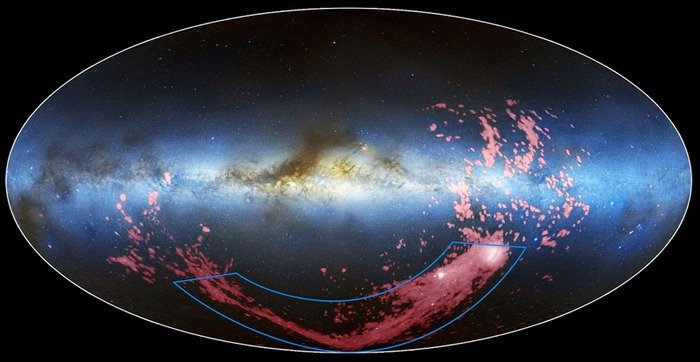The Magellanic Stream, a cosmic ribbon of gas wrapped around our Milky Way galaxy. Credit: Space Telescope Science Institute
PARIS, Aug. 8 (UPI) -- U.S and European astronomers say the Hubble space telescope has helped them identify the source of a cosmic ribbon of gas wrapped around our Milky Way galaxy.
New Hubble observations have solved the 40-year-old mystery of the origin of the Magellanic Stream, a long ribbon of gas stretching nearly halfway around the Milky Way, the European Space Agency reported Thursday.
Most of this gas stream was stripped from the Small Magellanic Cloud some 2 billion years ago, with a smaller portion originating more recently from its larger neighbor, the astronomers said.
The Magellanic Clouds are two dwarf galaxies orbiting our galaxy are at the head of the huge gaseous filament dubbed the Magellanic Stream.
Since the early 1970s, astronomers have been attempting to determine if the gas comes from one or both of the satellite galaxies.
They used Hubble observations, along with data from ground telescopes, to measure the abundances of heavy elements such as oxygen and sulphur at six locations along the Magellanic Stream.
A low level of oxygen and sulphur along most of the stream matches the levels in the Small Magellanic Cloud about two billion years ago when the gaseous ribbon was thought to have been formed.
However, a much higher level of sulphur was detected in a region closer to the Magellanic Clouds.
"This inner region is very similar in composition to the Large Magellanic Cloud, suggesting it was ripped out of that galaxy more recently," Andrew Fox at the Space Telescope Science Institute in Baltimore, Md., said.
"Exploring the origin of such a large stream of gas so close to the Milky Way is important," Fox said. "We now know which of our famous neighbors, the Magellanic Clouds, created this gas ribbon, which may eventually fall onto our own galaxy and spark new star formation. It's an important step forward in figuring out how galaxies obtain gas and form new stars."















